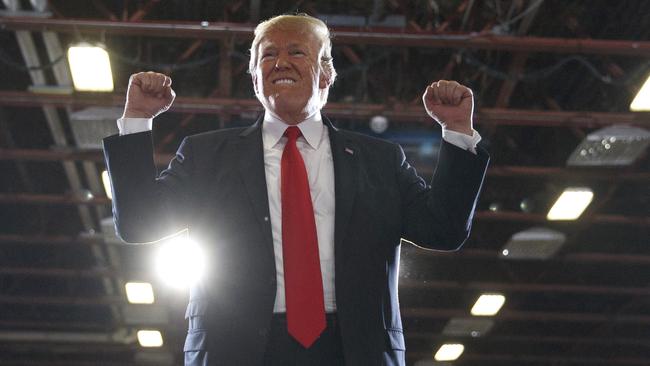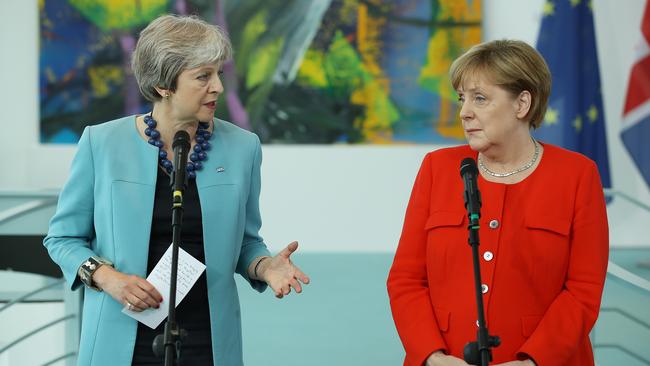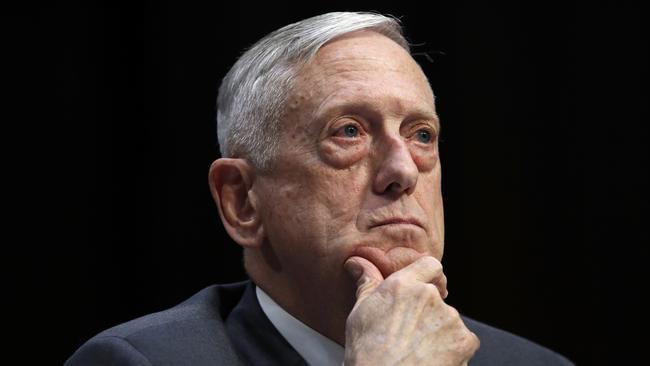NATO members wait to see which Donald Trump turns up at summit

First came the fiasco of the G7’s summit last month in Charlevoix, Canada, when US President Donald Trump refused to sign the final communique amid angry tweets from Air Force One. Now for the sequel.
Many fear an even more damaging bust-up at the NATO summit to be held in the 29-member alliance’s new headquarters in Brussels on Wednesday and Thursday. It features the same lead characters.
“We’ve seen that movie and it didn’t end well,” says James Stavridis, dean of the Fletcher School at Tufts University and a former supreme allied commander Europe.
Although the US President has affirmed his commitment to the alliance, some suspect his support is at best skin-deep. On the campaign trail he described NATO as “obsolete” and at Charlevoix he is said to have called it “as bad as NAFTA”, a trade agreement he regards as a rip-off. He resents his allies for failing to bear their fair share of the costs of defending Europe. Never mind that some of them put their soldiers in harm’s way in perilous places such as Helmand province in Afghanistan.
His view of their efforts boils down to a single number: the share of gross domestic product spent on defence, and whether it meets NATO’s guideline of 2 per cent. Hence the letters he sent to fellow NATO leaders last month bluntly urging them to do better.
It would become “increasingly difficult”, he told Norwegian Prime Minister Erna Solberg, among others, “to justify to American citizens why some countries fail to meet our shared collective security commitments”.
The letters to Norway and Canada found their way on to the internet. The one to Germany was particularly sharp, judging by extracts in The New York Times. “Continued German underspending on defence undermines the security of the alliance and provides validation for other allies that also do not plan to meet their military spending commitments,” Trump told German Chancellor Angela Merkel. (Britain, which does meet the 2 per cent target, got a subtler prod from US Defence Secretary Jim Mattis, who wrote to his British counterpart that Britain risked being eclipsed by France as America’s “partner of choice” if it did not invest more.)

Trump’s confrontational approach has only added to worries that a full falling-out is only an intemperate tweet away. It comes on top of his rejection of the nuclear deal with Iran and the fight he has picked over trade tariffs.
Given the potential for trouble, why bother to meet at all? Having Trump sit and listen as other leaders drone on would seem the perfect way to exasperate him. In the alliance, “you don’t actually need summits for anything”, points out Ivo Daalder, a former US ambassador to NATO. The allies’ political body, the North Atlantic Council, can take binding decisions. As it is, its 29 members must brace themselves for a wide range of potential outcomes.
Triumphant, tetchy
or torpedoed
One possibility (call this scenario Triumphant Trump) is that the summit goes fine. Trump is said to hate appearing predictable, so he may surprise everyone by behaving himself. He could point to increased NATO defence spending and decide to declare victory. Last year saw “the biggest increase in defence spending across Europe and Canada in 25 years”, says NATO secretary-general Jens Stoltenberg. Since the beginning of last year the number of allies on track to spend 2 per cent of GDP on defence by 2024 has more than tripled, from five to 16, according to Wess Mitchell, US assistant secretary of state for Europe. The number allocating at least 20 per cent of that budget to major equipment (another pledge from a summit in Wales in 2014) has risen from 14 to 24.
Last year Trump tweeted that “money is beginning to pour in — NATO will be much stronger”. Although NATO’s bigger budgets are largely a response to Russia’s invasion of Ukraine, Trump could boast that his pressure made the difference.
To bolster NATO’s eastern frontier, US forces are now deployed in Poland, and there are contingents led by Canadians in Latvia, Britons in Estonia and Germans in Lithuania. NATO has tripled the size of its rapid-response force and set up a taskforce ready to move within 48 hours. The allies have held firm on sanctions against Russia.
In Brussels this week they will agree to be ready for “four 30s” by 2020: the ability to move 30 mechanised battalions, 30 air squadrons and 30 combat ships within 30 days. They will endorse new command centres in Ulm in Germany and in Norfolk, Virginia. They will extend funding for the mission in Afghanistan and launch an enlarged training mission in Iraq. They plan to show that the door remains open to new members by announcing accession talks with Macedonia, now that the country is on its way to resolving a dispute with Greece over its name, and they will pledge closer collaboration with the EU.
None of this points to an alliance in crisis. With the help of the reassuring Mattis, things are running smoothly. “People who think we’re coming apart from within are wrong,” says Michael O’Hanlon of the Brookings Institution think tank.

Yet Trump may be less interested in a declaration of victory than in keeping up the pressure on US allies. He “grows more, not less, convinced over time that the allies are out to take advantage of the United States”, says Kori Schake of the International Institute for Strategic Studies in London. That mindset suggests a second summit scenario: Tetchy Trump, in which the President stars as berater-in-chief.
If so, he will have no shortage of targets. Military exercises have revealed glaring shortcomings in the ability to move forces swiftly across Europe, both because of bureaucracy (Customs officials asking to see passports at borders) and inadequate infrastructure (the bridges, roads and railways that have to handle military transports). The allies’ spending may have risen, but not by enough. Germany still falls far short of NATO’s 2 per cent-of-GDP guideline. Even the country’s stated aim of reaching 1.5 per cent of GDP by 2024 is not matched by actual spending plans, which suggest the share will remain at about 1.2 per cent, notes Claudia Major of the German Institute for International and Security Affairs in Berlin. None of Germany’s six submarines is operational. Only four of its 128 Eurofighter jets are combat-ready. “We failed” on the defence budget, says Major. Germany is now “paying the price for a very long neglect”. Trump has other grudges against Germany, from its trade surplus with the US to its support for the Nord Stream 2 pipeline that will increase its dependence on Russian gas.
But Germany is not the only potential focus of a falling-out. There are deep disagreements over Iran, and strains with Turkey over its intention to buy a Russian air-defence system. Noisy rows would risk undermining the sense of political unity on which deterrence depends. They also could distract NATO’s attention from the things it needs to focus on, such as improving its cyber defences.
Still, as Stoltenberg stresses, the alliance has survived rows in the past, from Suez to the Iraq war. Arguments can be healthy. The secretary-general has welcomed Trump’s strong message on spending. In the absence of the old Soviet threat, forcing people to explain what NATO does and why it is needed may be no bad thing. The real fear is that things could spiral out of control — that, as Major says, “because of different world views, this summit might actually explode”.
Hence a third version of the summit: Torpedo Trump. NATO’s nightmare is that a frustrated Trump openly questions the US commitment to Article 5, the alliance’s mutual-defence clause, under which an attack on one member is viewed as an attack on all. He may tell the allies, for example, that they can’t count on Article 5 unless they hit the defence-spending target of 2 per cent of GDP. Having thus shaken the foundations of the alliance’s collective defence, a few days later the President proceeds to embrace Russian President Vladimir Putin in Helsinki and agrees to cut back on “expensive” troop deployments in Europe and “provocative” missile defences. In other words, the sequence becomes a replay of the G7 falling-out followed by the embrace of Kim Jong-un of North Korea.
A plausible nightmare
What makes this scenario possible is that doubts about Article 5 seem to be lodged in the President’s mind. In a speech when NATO leaders last met, he pointedly left out any reference to it. And his America First reservations about multilateral arrangements, from the G7 to the World Trade Organisation, North American Free Trade Agreement and NATO, run deep. Last week exasperation at Trump’s attitude to the EU and the alliance led to the resignation of America’s ambassador to Estonia. “There used to be a suspicion that Trump doesn’t understand alliances, that he just sees them as encumbrances,” says Jonathan Eyal of the think tank RUSI. “It’s gone further than that — a thought in Europe that he wants actively to undermine them.”
Maybe disaster can be avoided this time. But worries about whether Europeans can continue to count on the US did not begin with Trump. In France, says Alexandra de Hoop Scheffer of the German Marshall Fund, the turning point came when Barack Obama failed to enforce his “red lines” on Syria in 2013. Yet so far the Europeans have taken only baby steps to develop their own defence efforts.
Amid strains on national budgets, the political appetite for big increases in defence spending is missing. At the EU level, collaborative defence initiatives tend to be bureaucratic (its Permanent Structured Co-operation is as cumbersome as its name suggests). Some have higher hopes for the new “European intervention initiative”, a brainchild of French President Emmanuel Macron that involves nine countries including Britain, even though it is leaving the EU, and aims to muster coalitions of the willing for joint action in a future crisis. But it was born only last month and its effectiveness remains to be seen.
All of which means the Europeans’ ability to push back against Trump’s disruptive instincts is limited. The allies are left hoping that any summit damage will not be too serious. “It is not written in stone that the transatlantic bond will survive forever,” Stoltenberg said in a speech in London last month. “But I believe we will preserve it.”


